Hands On with the Final NVIDIA Shield Hardware, Update: Now with Video
by Brian Klug on June 11, 2013 2:20 AM EST- Posted in
- Smartphones
- Android
- Mobile
- Tablets
- Android 4.2
- Shield
- Tegra 4
- NVIDIA
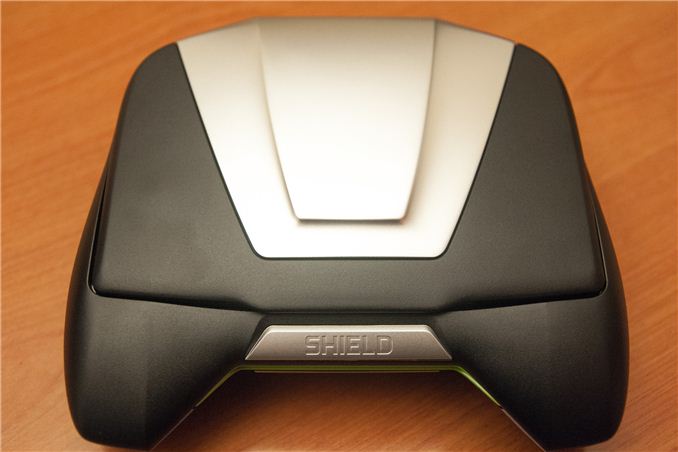
It seems like forever since CES 2013 when we first laid eyes on and played with NVIDIA’s Project Shield. Time flies, and since then Shield has dropped the Project and become just NVIDIA Shield. It’s not every day that we get to see a product go from being an early prototype with its own set of issues to final hardware ready to go into manufacturing in large numbers, but with Shield we’ve been given that very opportunity. Both Anand and myself got a chance to take a look at NVIDIA’s final Shield hardware.
Shield is of course NVIDIA’s reference Tegra 4 tablet turned part gaming controller slash PC streamer, part handheld gaming console running Android. Inside is of course the Tegra 4 SoC with four ARM Cortex A15s running at up to 1.9 GHz and 72 core GPU built on TSMC’s 28nm HPL process. It’s topped by a 5-inch 720p 294 PPI display and comes with 16 GB of internal storage, 2 GB of DDR3L, 2x2:2 802.11n dual band WiFi, and a microSD card slot. Atop all of that runs Android 4.2.1, but 4.2.2 is coming. Again Shield will always basically be running the latest stable version of the NVIDIA Tegra 4 BSP (Board Support Package) software, and updates come from NVIDIA. The specs really don’t tell the whole story though – and they haven’t changed – the key is in the subjective feel and ergonomics of Shield as a controller and its ability to be a standalone gaming console.
To say that Shield has come a long way is to put it lightly. The early hardware was very prototype-y, with a D-Pad that was mushy, triggers that didn’t feel right, analog sticks that weren’t tuned yet, and buttons that didn’t feel communicative enough. Even at Google I/O, NVIDIA was showing off Shield with hardware that wasn’t quite final yet, with a mushy D-Pad and analog sticks that still didn’t feel quite right to me.
The final Shield is much, much better.
NVIDIA’s tuning to the Shield hardware focused on pretty much all the points we touched on as concerns regarding the controller. I find myself drawing comparisons between Shield and the Xbox 360 controller since it reflects my almost-ideal controller. On the final Shield hardware the analog sticks have nubs on them and have a good amount of resistance, and are textured nicely.
The all-important D-Pad is much more communicative and clicky. I’m not much of a platform player however so I’m not sure if it will appease everyone, I’m also not sure if this is a hat switch or not, but I had no problem knowing whether I was pushing up down left or right. The triggers on the back likewise have much better resistance, and both bumpers have great crisp breaks. The remainder of the buttons likewise are clicky and responsive.
Talking about a controller for me isn’t so much finding things that are well done as things that fade into the experience and can be taken for granted, and in my hour or so with Shield I can’t think of anything that would frustrate me. That said it’s hard to really know where a controller or interface is going to fatigue you until you’ve used it for a few hours.
That brings me to the weight and mass question. NVIDIA moved around the batteries inside Shield, but the overall balance still feels good. What’s really different to me about Shield versus holding any of the other controllers (PS3, Xbox 360 Wired or Wireless) is how I can rest the whole console in basically both palms. The topology of the underside essentially rests on a shelf formed by your fingers. It’s hard to describe, but I’m reminded of my favorite Xbox 360 controller by Scuff gaming with the underside buttons which make you put your hands that way.
The final Shield hardware also has a significantly beefier display hinge, which makes the whole thing feel more snug and solid. There’s also that new metal Shield logo at the bottom between the front air intake (yes, Shield’s Tegra 4 remains actively cooled with a fan that kicks in after it crosses a certain temperature). If I could describe the final Shield hardware it honestly would follow that language – tougher and beefier and less delicate.
The buttons now navigate through Android much more effectively as well. Left and right bumper take you through pages in the launcher, reminiscent of the navigation on the Xbox 360. The left analog stick works like a virtual mouse and pops up a cursor, the D-Pad accordingly works like you’d expect. I found myself using those controls more than the touchscreen, though there are inevitably actions (both in games in Android) which require you take a hand off of balancing Shield and interact with the display.
I still however find myself wishing that the LCD display was bigger. Not because 5-inches diagonal is too small, or 720p too low res, but because the large black bezel around the thing makes it still look a rather awkward. I’m surprised NVIDIA couldn’t cut a deal with LG for some of their bigger 1080p panels (like the one from the Optimus G Pro) but I suspect there’s no easy way to get something better without compromising price point. The form factor of Shield also necessitates a landscape layout, and landscape layouts have been something of a rarity in Android since the departure of handsets with QWERTY hardware keyboards. There’s more than a few apps which only work in portrait or have some view which works only in portrait, but hopefully NVIDIA and Shield both will persuade some of this to change back.
The remainder of the equation for Shield’s viability as a console remains a software one, and here NVIDIA has to rely on the Android platform’s ability to deliver games customers want. Shield is effectively a gaming console running Android, something everyone talks about but nobody has really executed or delivered on entirely (sorry Ouya) – at least yet. Shield will ship with a few gaming related preloads, Sonic 4 Episode II THD and Expendable: Rearmed for games, plus Twitch TV and Hulu+ apps optimized for Shield. Of course there’s Google Plus and NVIDIA TegraZone as well. Beyond that though NVIDIA is relying on Android developers to make games which work and play well on Shield’s rather unique form factor. At launch, NVIDIA claims it will have 30 optimized titles available which work well with the controller and are optimized for landscape displays. Of course any game on Google Play with controller support will work on Shield.
The PC streaming aspect remains a second way to use Shield, and it’s a big sell in for a beefy desktop GPU, even if Shield becomes little more than a video decode sink and controller. In this setup, your NVIDIA based PC actually handles all of the 3D rendering before encoding the frame buffer as a video stream and sending it over WiFi to Shield. Presently, this personal GPU cloud only works in a 1-to-1 (one desktop to one Shield) ratio and it's only designed for local use.
Latency is impressively low and there’s minimal to no hitching. I played Borderlands on Shield connected to a Falcon Northwest box with GeForce Titan inside and found it more than playable. The obvious end goal however is to use some GPUs virtualized in the cloud with GRID and stream games to Shield, but it’s not quite there yet.
I find myself wishing that NVIDIA could launch Shield as a Nexus Experience device of some kind as a flagship platform with the new Google Play gaming services APIs as the context, but I’m not sure that’s in the cards. NVIDIA is steadfast with its “late June 2013” ship date, price remains $349 for NVIDIA’s foray into handheld gaming with Tegra 4.


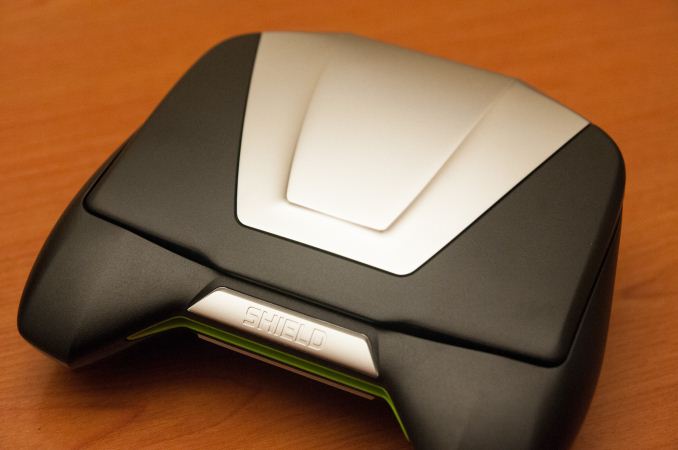

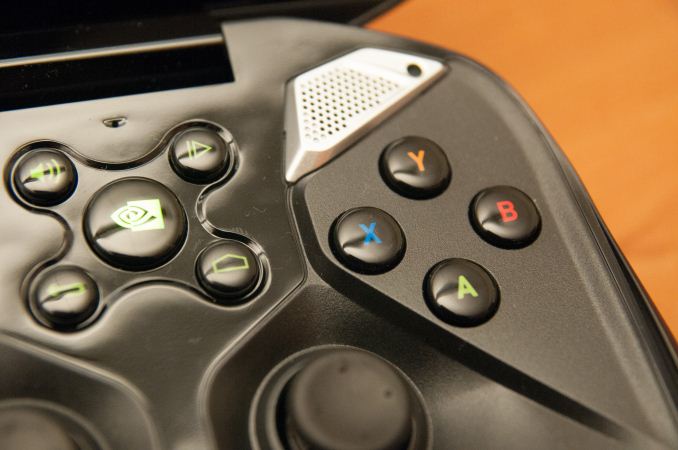
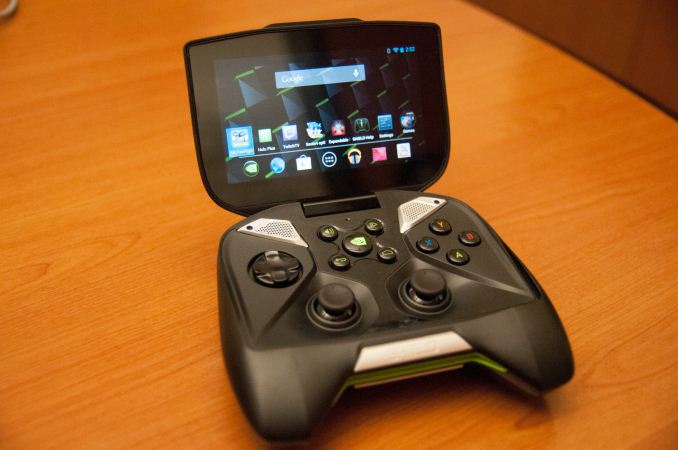
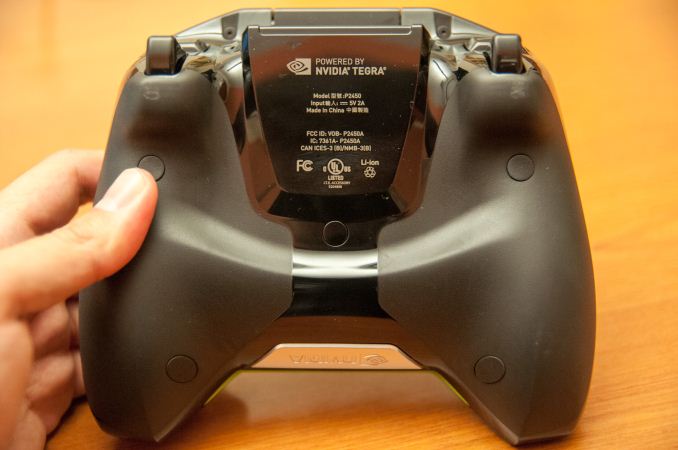














46 Comments
View All Comments
syxbit - Tuesday, June 11, 2013 - link
It has a fan???Count me out.
Torashin - Tuesday, June 11, 2013 - link
What an absolute POS. Why would anyone buy one of these?roc1 - Tuesday, June 11, 2013 - link
Apologies, but people bashing the price of Shield are unreasonable. It is a great value when you consider:1. NVIDIA makes no money on games. Android games cost $0-10, while XBOX or PS games cost $60. Now factor into the price of the device the cost of 10 games and then compare end prices.
2. Shield gives you more hardware than a high-end phone, yet costs less. Contrast the ~$500 unsubsidized phone price with $350 of the Shield. It doesn't have a modem, but comes with a controller and a fan! :P
etamin - Tuesday, June 11, 2013 - link
Most of your points are valid, but the problem is, no matter how impressive the hardware is or how thin the margins are for Nvidia, the vast majority of consumers could care less. I wonder how many self proclaimed "gamers" even know what an SoC is....they're just going to see a high price tag, limited titles, and a bulky device. I think the only way this platform can take off is if initial reviews are stellar and the platform gets more publicity.Also, I may have missed this part in one of the articles, but what about battery life? can Tegra 4 handle 3 hours of uninterrupted play? I would imagine it will get pretty hot if playing while plugged in. (is the battery removable btw?)
I wouldn't compare it to an unlocked phone...it's just too different. Modem/baseband aside, wouldn't it be awkward using the touchscreen keyboard or playing traditional touchscreen games?
In terms of relative price point, I'd say the Shield compares to the Razor gaming notebooks, except margins are probably much worse. Pushing the limits of "value" for gamers is a risky strategy. Who knows how astronomical R&D costs were...I honestly don't think this was a wise endeavor for Nvidia in the short term, but someone had to come out with a first gen device of this kind eventually.
Jumangi - Saturday, June 15, 2013 - link
Lolz...yea those games will be just like Assasins Creed, GTA V and the like....LMAO at the sad little Nvidia fanboy trying to justify a dumb pointless product.pancakes - Tuesday, June 11, 2013 - link
Does the remote play stuff only work with certain games? What about games that are compatible with Steam Big Picture mode? I know Borderlands 2 works, but what about something like Bioshock Infinite, which has full controller support?Ryan Smith - Tuesday, June 11, 2013 - link
Based on NVIDIA's previous statements it should work with anything that offers controller support. That's most action and driving games these days, though you're not going to be playing strategy games this way.eagle63 - Tuesday, June 11, 2013 - link
I'm surprised at how many "DOA" and "this thing will never succeed" comments I see. This is not a mainstream device and Nvidia knows that. It's not competing with the Nintendo DS or the PS Vita. They know they won't see a whole lotta sales with this thing. They made it for 2 reasons:1. A reference device to show off Tegra 4. They want to become a first-tier player in the smartphone/table soC game and this gives them a way to show off Tegra and hopefully garner some developer support.
2. A device to excite their base of serious PC gamers and fans. (this probably being the far lesser of the 2 reasons)
With all that in mind, I'm actually pretty excited. Yes it's pricey, but the hardware seems great and - as others have said - this could serve nicely as a video streaming device when it's not playing games.
TheJian - Wednesday, June 12, 2013 - link
These should sell well, even vs. Vita ($50 less) or 3DS (100 less). They do so much more already. NV can really kick things off by making a gaming announcement. Say something like MS with the 1B in games. But instead say 100mil per year for 20 exclusives (5mil per game should net AAA quality games) for the next 4yrs guaranteed thus showing they will make sure you get top quality games (not much more than Intel's free payment each year - just ONE of those payments covers 300mil). It should be easy to recoup that and you can sell them on PC a year later or two later with physx/cuda etc support so they sell more gpus on pc...LOL. Considering even how Vita and 3DS have sold (7mil and 40mil units), just selling a million of each game to shield owners at 5bucks nets a break even on a 5mil dev game and kills handhelds totally. But then Square Enix and EA charge $15-20 for their AAA games on mobile, so you could easily charge $10-15 which is still short of Vita/3DS at $20-36 for their games.Wiiu and 3DS games are estimated to cost 600K-2mil per game for dev. Clearly NV could afford to fund a LOT of great experiences to sell us this 720p handheld that dwarfs 3DS/Vita resolutions, function and power. Not to mention hdmi out to tv so no need for consoles, browsing on TV (it uses android and virtual keyboards after all - along with all android apps/games). They could also allow the exclusive games on T4i/T4 devices of course so even more sales potential. If they make great games they sell themselves at $10. The total of T4/T4i devices will be over 10mil no doubt so only selling to 1/10 of the audience gets your money back on each game easily and promotes the platform just as MS is attempting to do with Xbox1. It should be easy to promote them to NV gpu gamers a year or two later after each one comes out if you haven't recovered the dev money on a game.
NV sold 9.5mil discrete cards this Q (out of 14.8mil), so there's plenty of people buying new cards each quarter even as NV exclusives. They can do it many ways but the point is you can get your game dev money back easily between mobile and pc. Since they'd likely run on AMD hardware on PC, charge NV customers $10 for the game and $15 to AMD people on PC...LOL. Torchlight 2 sold 1mil units before Jan1 2013 (just 3 months), so you can easily sell games at $20 to pc users if they're quality. NV has no EA/Activision etc overhead and could just add these people under their umbrella to pump out great games cheaply. Tegrazone & googleplay are all you need for advertisement. They already sort of help by lending engineers to devs to help push features, but that isn't enough IMHO. Put some real money behind the games.
Apple should have done the same thing 3yrs ago and we might not even be seeing shield, ouya, wikipad, gamepop etc etc as they could have owned this whole market by putting out 100 AAA games each year as exclusive to apple only! I mean even 500mil/yr for 10yrs of games is only 5B. Apple has 140B. This is the most wasted opportunity I've seen in years. They have a few hundred million to sell to that have very good gpus and surely will add more with the next ipad/iphone. They could have a 300 AAA game catalog already in the books and building more. Heck they could have put out a console this year to add more fuel to APPLE ONLY gaming. They are STUPID. I'm no apple fan but I would have destroyed everyone in gaming with 140B...LOL. Think about say 1B a year for the next 5yrs even. That's a crapload of games even at 10mil per game that's 100 games a year and those are expensive by today's standards. The witcher 1 & 2 were made for ~7mil each and they were both AAA. Torchlights were made for ~2mil each I think, and again seriously fun. Look at all the kickstarter's being done for 4mil or less and a lot of puzzle/adventure point click crap is cheap to make, but again has an audience - The walking dead 5eps would bore me to death but someone loves it...LOL.
The person who dominates the games will win the next war. Which is why Vita/Wiiu is having such a hard time - no games (or dev support), and 3DS is losing lots of support to as everyone goes to mobile. Apple could have ruled by now, and if NV is listening MAKE YOUR MOVE NOW! A few hundred million (they have 3.7B and intel pays them yearly to 2016) can change the value of your console, further push NV gpu's and at worst probably break even or make money on the games. It wouldn't be long and you're making a ton on the games due to a larger base between phones/tablets and rev2 or rev3 with later tegras in shield (T5/T6).
MS is having to do this 1B into gaming as a defense move due to DRM scandal, used games scandal, 24hr check-in etc. NV or Apple (Qcom too) can all do it from OFFENSIVE positions.
Shield is about as DOA a product as Titan which still is basically selling every one they make at $1000. Anyone thinking these won't sell decent vs. 3ds/vita are sadly mistaken. Running vanilla android was brilliant (and surely makes Google happy vs. forking and ticking them off) with access to everything android out of the box. Some stuff may need tweaks but it shouldn't be tough to get most stuff running fine to keep users very busy. Myself, Maxwell first, maybe shield T5 then next June :)
jelloboy - Wednesday, June 12, 2013 - link
I wish there was more information on the Steam streaming -- you say the latency is impressively low but does that mean it plays exactly as you'd expect?